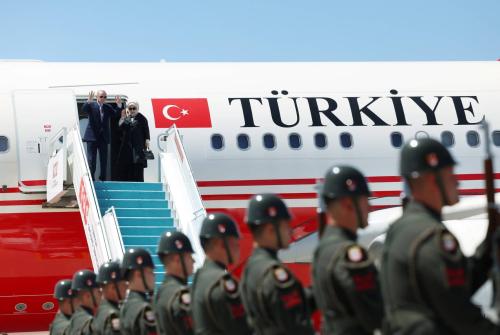Thomas Wright is author of All Measures Short of War: The Contest for the 21st Century and the Future of American Power.
When NATO leaders meet in Brussels on May 25, they will participate in a ceremony to dedicate the new NATO headquarters. To the left of the main walkway, Chancellor Merkel will unveil a section of the Berlin Wall, signifying how NATO kept the peace during the Cold War. To the right, President Trump will unveil a section of the World Trade Center, officially named The 9/11 and Article 5 Memorial, signifying the only time in its history that NATO invoked Article 5, the mutual defense clause. Over 1,000 soldiers from America’s NATO allies subsequently died in the Afghanistan War.
The Brussels mini-summit is supposed to affirm the relevance of the alliance in the Trump era but there is a risk that it could severely undermine it. President Trump is the only American president since NATO’s founding who has not explicitly endorsed Article 5. His vice president and his secretary of defense have but he has not. If he fails to do so in Brussels, it could raise grave doubts about the credibility of the American security guarantee and provide Russia with an incentive to probe vulnerable Baltic states.
President Trump’s reticence on Article 5 has been largely overlooked because of his recent remark that NATO is no longer obsolete. But, a close reading of Trump’s statements reveal that his policy shift is much smaller than it appeared at the time.
President Trump is the only American president since NATO’s founding who has not explicitly endorsed Article 5.
Donald Trump’s first major statement about NATO came in March 2016 in an interview with The New York Times. He said the alliance was obsolete for several reasons. The first was that Russia no longer posed the threat the Soviet Union did. The second is that NATO was not focused on counterterrorism. The third is the financial cost of NATO to the United States.
In the year that followed, Trump doubled down on this critique, particularly on terrorism and burden-sharing. He repeatedly argued that NATO members must pay up if they were to receive U.S. protection. In July 2016, he said, I want to keep NATO but I want them to pay. I don’t want to be taken advantage of…We’re protecting countries that most of the people in this room have never even heard of and we end up in world war three…Give me a break.”
After taking office Trump claimed credit for a shift on burden sharing and counterterrorism. He told a joint session of Congress that the “money is pouring in. Very nice.” When he met the NATO Secretary General Jens Stoltenberg in April, he said: “I complained about that a long time ago, and they made a change — and now they do fight terrorism. I said it was obsolete. It’s no longer obsolete.”
The crucial nuance is that Trump did not say that NATO’s original mission of countering Russian power in Europe is no longer obsolete. Indeed, he has never acknowledged this. The closest he has come is a general statement of strong support with caveats attached for burden sharing and counterterrorism. Trump’s failure to endorse Article 5 is not an oversight. Members of his cabinet have unsuccessfully tried to insert this language into his remarks, including at his meeting with Stoltenberg.
Compare this with Trump’s predecessor. President Obama went to Estonia in 2013 and said:
“I say to the people of Estonia and the people of the Baltics, today we are bound by our treaty Alliance. We have a solemn duty to each other. Article 5 is crystal clear: An attack on one is an attack on all. So if, in such a moment, you ever ask again, ‘who will come to help,’ you’ll know the answer—the NATO Alliance, including the Armed Forces of the United States of America.”
One can criticize President Obama’s Russia policy but he understood the sacred importance of Article 5.
Others in the administration have attempted to compensate for the president’s reticence. Secretary Mattis and Vice President Pence explicitly endorsed Article V of the NATO Treaty at the Munich Security Conference in February of this year. Mattis called it a “bedrock commitment.” Pence said it is “one of two core principles that are central to” NATO’s mission and that U.S. support for the alliance is “unwavering.”
Mattis and Pence have helped bolster U.S. credibility on NATO as has the continuing deployment of U.S. forces and assets to Eastern Europe which began under the Obama administration. But ultimately the decision to uphold U.S. commitments lies with the commander-in-chief. He alone decides whether and how the United States will respond to a Russian attack on a NATO member.
President Trump needs to state his support for NATO’s original mission and America’s solemn commitments if the alliance is to be as effective in the future as it has been in the past. Trump has already moderated his position on U.S. alliances. When he stands beside a piece of the wreckage of the World Trade Center, he should complete his journey and say what every postwar president has said—the United States will stand by its allies in NATO by honoring its commitments under Article 5.
The Brookings Institution is committed to quality, independence, and impact.
We are supported by a diverse array of funders. In line with our values and policies, each Brookings publication represents the sole views of its author(s).








Commentary
Trump’s NATO Article 5 problem
May 17, 2017